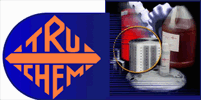

|
T.C. 104 |
||||||
|
||||||
 |
 |
|
| MISSION STATEMENT | HOME |
|
|
DESCRIPTION T.C. 104, as shipped, is a fluid liquid, somewhat translucent, with a light greenish color. It has a viscosity slightly greater than water. The concentrated material and its solutions are moderately alkaline, giving pH values between 8.5 and 9.5 at 20° C. The product is stable and resistant to heat and contamination to unusually degrees in normal use, although adulteration with mineral acids should be avoided. A tendency for the collection of a thin layer of light yellow froth upon the surface of the undiluted liquid is normal and indicates that the solution is saturated with one of the inhibitors. T.C. 104 is completely dilutable with water to form uniform dispersions of somewhat turbid characteristics but leaves films on metals after drying of non-tacky properties and high resistance to oxygen attack. The films are also a barrier to sulfurous and ozone fumes resulting in a special beneficial anti-tarnish attribute when applied to silver and copper alloy surfaces. The non-oily properties of the protective films generally permit adhesions to labels and decals, or the application of paints frequently used in color-coding metal parts. The films also have certain qualities of lubricity which make them resistant to abrasion and wear, and aid in the torque and leak-sealant function of threaded fittings and screw fasteners. PURPOSE T.C. 104 is designed to provide indoor protection against corrosion and tarnish on the surfaces of iron and steel parts, as well as on the surfaces of copper, brass, aluminum and aluminum alloys, zinc and galvanized articles, and on silver and zinc phosphate coatings. APPLICATION T.C. 104 is applied by tank immersion methods from full strength down to 2% volume. Average indoor protective values are normally obtained in the concentration range of 5% to 20% by volume. For more corrosive environments, the use-concentration should be increased as needed. Temperatures employed may be 100°F - 130°F. No water rinse is required, and the work should be dried by evaporation in air or by forced hot air to set up the protective films. |